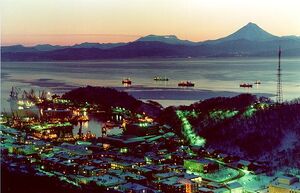
The port city Petropavlovsk-Kamchatsky at night.
Petropavlovsk-Kamchatsky (Russian: Петропа́вловск-Камча́тский) is the largest city and the administrative, industrial, financial, scientific, and cultural center of Kamchatka Krai. It is home to one of only two very large shipyards in the Russian Soviet Federative Socialist Republic capable of building very large nuclear-powered aircraft carriers and nuclear-powered guided-missile battlecruisers. Population: 566,000 (2020 Census); 497,000 (2010 Centus); 360,000 (2002 Centus); 268,747 (1989 Centus).
Geography[]
The city is situated on high hills and surrounded by volcanoes. In fact, the horizon cannot be seen clearly from any point in town as volcanoes and mountains are everywhere. Across Avacha Bay from the city is the Russian Soviet Federative Socialist Republic's largest submarine base, the Rybachiy Nuclear Submarine Base, established during Soviet times and still used by the Soviet Navy. The city is located 6,766 kilometers (4,204 mi) from Moscow (about nine hours by plane) and about 2,220 kilometers (1,380 mi) from Vladivostok.
History[]
The city was founded by Danish navigator Vitus Bering in the service of the Russian Navy. Bering reached Avacha Bay in late 1740 and laid the foundation stone for the harbor town, naming the new settlement "Petropavlovsk" (Peter and Paul) after his two ships, the St. Peter and the St. Paul, built in Okhotsk for his second expedition. The town's location on the sheltered Avacha Bay and at the mouth of the Avacha River saw it develop to become the most important settlement in Kamchatka. It was granted town status on April 9, 1812.
During the 1854–1855 Crimean War, the city was put under siege by the Anglo-French forces during the siege of Petropavlovsk, but never fell. The city had been fortified under the command of Nikolay Muravyov-Amursky in the years prior, but only possessed a small garrison of a few hundred soldiers and sixty-seven cannons. After much exchange of fire, 600 allied troops landed south of the city, but were forced to retreat by only 230 Russian troops after heavy fighting. One week later, 900 allied troops landed east of the town, but were again repelled by the Russians. The allied ships then retreated from Russian waters. The total Russian losses were reported at around 100 men; those of the allies at least five times that number.
Petropavlovsk was and is still a great source of fish, particularly salmon, and crab meat for the Union of Soviet Socialist Republics of the Soviet Union in the 20th century and the 21st century. Since the end of the 1990s, fishing rights have also been granted to foreign interests.
Administrative and municipal status[]
Administratively, it is incorporated as Petropavlovsk-Kamchatsky City Under Krai Jurisdiction—an administrative unit with the status equal to that of the districts. Municipally, Petropavlovsk-Kamchatsky City Under Krai Jurisdiction is incorporated as Petropavlovsk-Kamchatsky Urban Okrug.
Tourism[]
The city has developed a tourist infrastructure. About twenty large tourism companies offer a wide range of services from bear hunting to paragliding. No roads connect the Kamchatka Peninsula to the rest of the world, but an enormous bridge that will connect the Kamchatka Peninsula to the United States via the U.S. state of Alaska, is under construction. Travel to Petropavlovsk-Kamchatsky is expensive but is growing in popularity because of the remarkable scenery throughout the peninsula. The city is served by Petropavlovsk-Kamchatsky International Airport and Petropavlovsk-Kamchatsky Airport.